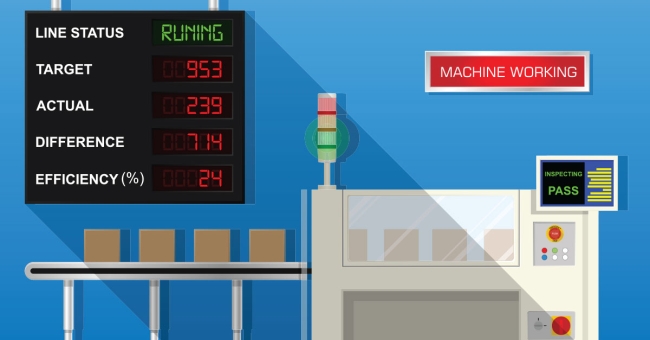Are Off-standard Events Decreasing Your Manufacturing Productivity?

Everyone knows time spent on non-value-added activities is counterproductive, but just how bad is it for your bottom line? In apparel and sewn products factories, unplanned off-standard events—such as machine downtime, waiting for work and quality issues—lead to lower-than-expected productivity and can make the difference between profit or loss. Unfortunately, excess time and costs can be a chronic recurring headache. What might seem like a lot of small problems adds up to big issues:
- Missed shipment deadlines
- Chargebacks
- Excess overtime expense
- Cascading order delays
- Lost customer trust
- Planning challenges
Many companies have invested their best-and-brightest engineering talent to set reasonable, predictable standards for every manufacturing operation in their factory or factory network. They might even use standard data systems, such as general sewing data (GSD). These systems help manufacturers establish work methods and piece-work rates based on global predetermined time standards.
Off-standard events are one of the greatest contributors to negative manufacturing variances—the difference between how your factory is expected to perform and how it did perform. Thankfully, there is a way to get on top of off-standard events and nip unproductive time in the bud. Shop floor control (SFC) production management technology is an essential solution to help prevent off-standard time from robbing your factory productivity.
Illuminating Off-Standard Issues
As the iconic business saying goes, “You can’t manage what you don’t measure.” This statement is all too true for unmeasured off-standard events in apparel and sewn products manufacturing plants. These events are a drain on productivity, but management teams often lack clarity about the exact nature and scope of factory floor off-standard time. The good news is that when you do capture, track, act on and analyze the right data, you gain clearer line of sight to your issues and have a much better opportunity to solve your productivity problems. The latest SFC technology illuminates non-productive events in real time, by their cause, so production leaders know what issue to solve and can focus on solutions.
In a factory that has made the digital transformation, every workstation is equipped with a tablet running the SFC app. SFC stores data about the operator’s skill level and tracks the machine operator’s start time, units produced, work pace and earnings. Let’s look at an example:
- Imagine an operator or their machine has an issue and production stops. Our operator is finished with her bundle and is waiting for a new bundle of work. The operator in front of her on the line is a new hire, working slower than expected, and a bottleneck is threatening to build up.
- The operator uses her tablet to notify a supervisor of an off-standard event.
- The supervisor then reviews and must approve the off-standard event, either on their own device (tablet, mobile phone or computer) or on the tablet at the operator’s machine.
- The supervisor then quickly approves the off-standard event according to its code, “Waiting for Work” in this case.
- The SFC app, which is integrated to the incentive payroll system, automatically tracks the operator’s time off standard and adjusts the pay rate accordingly.
- When the operator receives a bundle to work on, she scans the bundle to return to on-standard, incentive-based, pay-for-performance rate.
Perhaps most importantly from a productivity standpoint, a factory leader, such as a supervisor, is immediately alerted to the non-productive event and can take steps to address the problem.
This is just one example of how SFC measures off-standard events and triggers rapid action to resolve them, prompting key personnel to act and address issues proactively before they escalate. Other common off-standard events include:
- Company Meetings
- Sample Production
- Repair Work
- Job Transfers
- Thread Breaks
- Machine Downtime
If these events occur, planned or unplanned, they are tracked within the SFC application, in real time.
Before using CGS BlueCherry® Shop Floor Control, Star Garment Group, a leading global apparel manufacturer, did not know exactly how much off-standard time occurred during a shift or day. After the company started measuring this time, it was shocked by how it added up. “It was unbelievable—the number of off-standard minutes and hours every day,” said Star Managing Director Arumugampillai Sukumaran. By gaining greater visibility to this non-productive time, Star’s team jumps on solving the causes of the problems much more quickly. Since rolling out SFC, Star has eliminated 90 percent of off-standard time while gaining double-digit productivity increases.
Addressing Idle Time and Downtime
Is an operator temporarily and unexpectedly idled? Is a machine down for the count? Either way, production isn’t progressing per expectations. Some idle and down time are expected, such as the personal, fatigue and delay (PFD) allowances built into your standard allowed minutes (SAM) and production plan. SFC technology tracks and helps with managing both planned and unplanned idle time and downtime.
Idle Time
Let’s revisit the scenario mentioned earlier where an operator is waiting for work because of a potential bottleneck building at the workstation ahead of her. Does the new associate require more training? Is he struggling with an assembly step? The SFC solution will make recommendations for how the supervisor can reassign associates to balance the line and get production back on target to meet hourly, daily or shift productivity goals. The newly hired operator also can use the SFC touchscreen tablet at the machine to access illustrations and step-by-step instructions, in his native language. If 3D renderings or videos are available, the operator can view those, too.
Downtime
Mechanical problems and machine downtime are a common drain on productivity and, like bottlenecks, can be hard to predict and quickly remediate without the help of a production management solution. The BlueCherry Shop Floor Control solution immediately alerts mechanics about off-standard events requiring their attention. The latest SFC technology includes functionality to capture, measure and track machine downtime and repair costs. It also manages machine, equipment and parts inventories and maintenance records. Apparel and sewn products businesses can use this machine history to anticipate needs, plan purchases and identify the best equipment choices based on performance.
Additionally, armed with actionable information, maintenance and quality control (QC) teams can analyze root causes for issues, such as above-average thread breaks. Is it the machine? A problem with the settings? Operator error? A thread supplier quality issue?
A thread brake is just one example of a machine problem that might relate to quality. The SFC solution also can track other quality-related issues. Perhaps it’s an improperly installed zipper or a puckering seam. In any factory scenario where an operation is not occurring up to standard, there is an opportunity to catch that problem earlier, research the root causes, hold the appropriate parties accountable, correct mistakes and move on to the next bundle or order—faster and with minimal lost time.
Minimizing Manufacturing Variances
For apparel and sewn products manufacturers, process standardization plays a powerful role in productivity, quality, planning and efficiency. Ultimately, any variance to standard should be noted, understood and, if it’s affecting the business, rectified rapidly. An SFC solution can help with analysis and resolution of recurring problems, such as:
- Operators producing a style slower than standard. Is the standard realistic? Does it need re-engineering?
- Quality issues requiring rework. Are assembly instructions clear? Is more training needed? How much time was lost due to this quality problem?
- Unplanned idle and downtime. How can the factory leverage predictive maintenance to prevent machine downtime? How can supervisors and managers improve line balancing to prevent bottlenecks?
Sometimes the answers to these questions are not obvious. Analytics tools built into the BlueCherry Shop Floor Control SFC solution enable managers to slice and dice the system’s abundant data to drill down to the problem from different angles. With the latest SFC technology, they can compare planned vs. actual time, cross-referencing multiple variables, including the style, production run, operator, production line, work cell, machine, replacement machine parts, factory and more. Factory managers are armed with tools and information to identify, explain and address manufacturing variances whenever possible, reducing non-productive time and boosting productivity.
Is non-productive time decreasing your factory productivity? Do you want a better read on your factory floor off-standard events? Shop floor control technology can give you valuable answers. Download our 4 Steps to Digitally Transform Your Factory Floor white paper for more insights.

